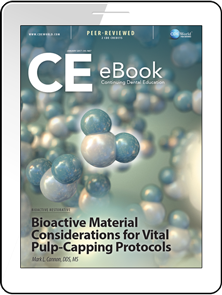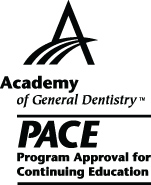CDEWorld > eBooks > Bioactive Material Considerations for Vital Pulp-Capping Protocols


ADA CERP is a service of the American Dental Association to assist dental professionals in identifying quality providers of continuing dental education. ADA CERP does not approve or endorse individual courses or instructors, nor does it imply acceptance of credit house by boards of dentistry. Concerns or complaints about a CE provider may be directed to the provider or to ADA CERP at www.ada.org/cerp/

Approved PACE Program Provider. FAGD/MAGD credit. Approval does not imply acceptance by a state or provincial board of dentistry, or AGD endorsement. 1/1/2023 to 12/31/2028. ID # 209722.
eBook
Released: Friday, January 6, 2017
Expires: Friday, January 31, 2020
Bioactive Material Considerations for Vital Pulp-Capping Protocols
By Mark L. Cannon, DDS, MS
Performing successful pulp-capping procedures is predicated on many factors, including selecting appropriate materials. In the past two decades, dental product manufacturers have demonstrated significant interest in developing materials that are biocompatible, bioactive, and non-cytotoxic and support dentin bridge formation. Today, a variety of bioactive dental restorative materials are available that promote remineralization and inhibit tooth demineralization. More recently introduced bioactive restorative materials contain calcium silicate, contribute to a more biomimetic restoration, mimic the physical characteristics of tooth structure, and stabilize and protect dental hard tissues. This article reviews the development of bioactive pulp-capping materials in response to demanding clinical requirements.
LEARNING OBJECTIVES:
-
Identify characteristics required of materials used in pulp-capping procedures.
-
Explain the mechanisms involved in the dentin mineralization process.
-
Describe the role of different bioactive pulp-capping material properties in dentin bridge formation.
-
Discuss the bioactive properties of hydraulic calcium-silicate cements.
About the Author
Mark L. Cannon, DDS, MS
Professor, Northwestern University, Feinberg School of Medicine in the Division of Dentistry, Department of Otolaryngology, Chicago, Illinois


